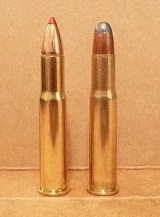
.32 Winchester Special
Encyclopedia
The .32 Winchester Special (or .32 WS) is a rimmed cartridge
created in October 1901 for use in the Winchester Model 94 lever-action rifle
. It is similar in name but unrelated to the .32-20 Winchester
cartridge (which is also known as .32 WCF).
cartridge of 1895, but differs from the .30-30 in bullet diameter. More significantly, Winchester decreased the rate of rifling twist in their Model 94 rifle, from 1:12 when chambered for the .30-30 to 1:16 when chambered for the .32 Winchester Special. Winchester used the slower twist to reduce fouling retention when creating a new cartridge for sportsmen who wanted to reload their own ammunition using black powder and cast bullets. It was also marketed as something more powerful than the .30-30 and yet had less recoil than the .30 Army. This new cartridge enjoyed only moderate success, and remained hampered by the small selection of available bullets in the .321 diameter. There is a wide selection of bullet types and weights for the .30-30, while the only commonly-available bullets in .321 diameter are 170 grain and 165 grain. Also, due to slow twist of barrel, accuracy suffered when barrel exhibited some wear.
, and correspondingly greater penetration. According to Winchester's original claims, the .32 WS has about 5-10% more energy than the .30-30 at point-blank ranges, and less at longer ranges due to increased drag due to the .321's greater diameter and reduced sectional density.
Cartridge (firearms)
A cartridge, also called a round, packages the bullet, gunpowder and primer into a single metallic case precisely made to fit the firing chamber of a firearm. The primer is a small charge of impact-sensitive chemical that may be located at the center of the case head or at its rim . Electrically...
created in October 1901 for use in the Winchester Model 94 lever-action rifle
Rifle
A rifle is a firearm designed to be fired from the shoulder, with a barrel that has a helical groove or pattern of grooves cut into the barrel walls. The raised areas of the rifling are called "lands," which make contact with the projectile , imparting spin around an axis corresponding to the...
. It is similar in name but unrelated to the .32-20 Winchester
.32-20 Winchester
The .32-20 Winchester, also known as the .32 WCF , was the first small-game lever-action cartridge thatWinchester produced. It was initially introduced as a blackpowder cartridge in 1882 for small-game, varmint hunting, and deer. Colt produced a single-action pistol chambered for this cartridge a...
cartridge (which is also known as .32 WCF).
History
This cartridge is based on the .30-30 Winchester.30-30 Winchester
The .30-30 Winchester/.30 Winchester Center Fire/7.62×51mmR cartridge was first marketed in early 1895 for the Winchester Model 1894 lever-action rifle. The .30-30 , as it is most commonly known, was the USA's first small-bore, sporting rifle cartridge designed for smokeless powder. The .30-30 is...
cartridge of 1895, but differs from the .30-30 in bullet diameter. More significantly, Winchester decreased the rate of rifling twist in their Model 94 rifle, from 1:12 when chambered for the .30-30 to 1:16 when chambered for the .32 Winchester Special. Winchester used the slower twist to reduce fouling retention when creating a new cartridge for sportsmen who wanted to reload their own ammunition using black powder and cast bullets. It was also marketed as something more powerful than the .30-30 and yet had less recoil than the .30 Army. This new cartridge enjoyed only moderate success, and remained hampered by the small selection of available bullets in the .321 diameter. There is a wide selection of bullet types and weights for the .30-30, while the only commonly-available bullets in .321 diameter are 170 grain and 165 grain. Also, due to slow twist of barrel, accuracy suffered when barrel exhibited some wear.
Performance
Ballistics are similar to the .30-30 cartridge and its .308 caliber (7.62mm) bullet, but the larger diameter .321 (8.15 mm) bullet of the .32 WS will create a larger wound. However, given the same weight of bullet in both calibers, the .30 caliber would have a greater sectional densitySectional density
Sectional density is the ratio of an object's mass to its cross-sectional area. It conveys how well an object's mass is distributed to overcome resistance. For illustration, a needle can penetrate a target medium with less force than a coin of the same mass...
, and correspondingly greater penetration. According to Winchester's original claims, the .32 WS has about 5-10% more energy than the .30-30 at point-blank ranges, and less at longer ranges due to increased drag due to the .321's greater diameter and reduced sectional density.

